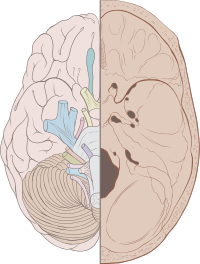
Photo from wikipedia
Introduction Surgery-related to lesions in or around the brainstem constitutes a challenge due to the extreme concentration of critical neural structures and the high risk of iatrogenic damage during surgery.… Click to show full abstract
Introduction Surgery-related to lesions in or around the brainstem constitutes a challenge due to the extreme concentration of critical neural structures and the high risk of iatrogenic damage during surgery. Intraoperative neurophysiological monitoring (IONM) have increased the feasibility and safety of brainstem surgery. We present a case of a patient who underwent posterior fossa surgery in where the laryngeal adductor reflex (LAR) was used to assess both lower brainstem and vagal nerve integrity. Methods A 62-year-old female scheduled for microsurgical resection of large left-Vestibular -Schwannoma with IOM. Anesthesia was maintained with TIVA. We applied LAR as a technique that provides functional information of brainstem and vagal nerve integrity, combined with other techniques currently used: Motor evoked potentials (MEP), somatosensory evoked potentials (SSEP), corticobulbar motor-evoked potentials (Co-MEPs), brainstem auditory-evoked potentials (BAER), blink reflex (BR) and cranial nerve mapping. LAR was elicited by a single electrical stimulus of the laryngeal mucosa (contralateral side to the operative field) using the electrodes attached to the endotracheal tube. Surface electrodes ipsilateral to the surgical field attached to the ETT were used to record the contralateral R1 (cR1) and R2 (cR2) responses of the LAR. Significant changes in LAR amplitude responses were the critical parameters for IONM interpretation. Results All MEP - SSEP – CoMEP – LAR - BR responses, were elicited bilaterally at the onset of surgery. During resection, the left trigeminal nerve was stretched, patient’s blood pressure (BP) and heart rate (HR) dropped drastically and concomitantly left blink reflex responses mildly decreased. The surgeon was informed immediately, surgical stimulation was discontinued. To counteract the bradycardia, atropine sulfate was administered; following with HR increased. Soon later, left blink reflex responses returned to baseline. There were no other IONM changes related to the event. Later, during the dissection of tumor adjacent to the left vagus nerve, severe BP and HR drop noticed. Once again, surgical stimulation was discontinued. Sinus rhythm, returned immediately after the procedure was stopped. The patient was given ephedrine again to counteract the bradycardia. At that time, bilateral LAR and ipsilateral vocal CoMEP responses decreased, with improvement when hemodynamic parameters returned to normal. During the end of resection, there were several trains of neurotonic discharges observed in the VII cranial nerve. Due to several IONM events and hemodynamic changes during the procedure, the surgical intervention was discontinued. Conclusion LAR is a novel method for assessing lower brainstem and vagus nerve integrity that can be useful for IONM during brainstem surgery; it shows consistent results and adds a new tool in the armamentarium of posterior fossa IONM where vagal nerve function may be compromised.
Journal Title: Clinical Neurophysiology
Year Published: 2018
Link to full text (if available)
Share on Social Media: Sign Up to like & get
recommendations!